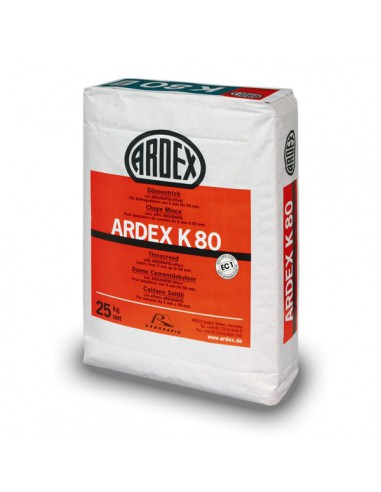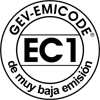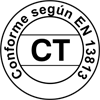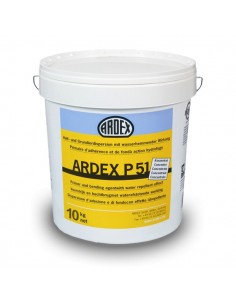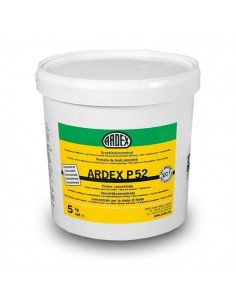Field of application:
Self-levelling mortar for levelling and renovation of concrete floors, cement and anhydrite screeds, ceramic, non-ceramic and other coverings.
Levelling paste for the creation of continuous surfaces of high strength and excellent durability.
Repair and levelling of screeds prior to laying continuous epoxy or multilayer flooring.
Ideal for floors in industrial buildings, warehouses, covered patios, garages, workshops and applicable in all types of industries, especially in the food industry and hospitals, because it is solvent-free.
In interiors only.
Characteristics:
Powder based on special cements and plasticisers with good dispersion capacity and special fillers.
Mixed with water, a soft, self-levelling and pumpable mortar is obtained, which can be worked in 1/2 hour and can be walked on in 3 hours.
The mortar dries and hardens by hydration, without shrinkage, avoiding the appearance of cracks.
Substrate preparation:
The substrate must be dry, clean, compact, free of dust and separating agents. To avoid the appearance of air bubbles and to improve adhesion on porous substrates, these must be prepared with Ardex P51, primer diluted with water in a 1:1 ratio.
The substrate must always remain dry. On dense or slightly porous substrates, prime with ARDEX EP2000 sandblasted to saturation.
Instructions for use:
Pour clean water into a clean container and add the powder, stirring vigorously with a stirrer, until a homogeneous, fluid mortar is obtained.
The mixing ratio is 4 3/4 - 5 1/4 l. per 25 kg.
The mortar can be worked for approx. 1/2 hour at temperatures between 18-20°C.
Low temperatures extend and high temperatures reduce the working time.
The mortar is easily spread by means of a spreader skid and smoothed with a smoothing trowel.
Layer thicknesses:
On concrete screeds, cement screeds and smooth non-porous substrates, to which a bonding bridge based on sandblasted ARDEX EP2000 has been applied, a layer thickness of up to 50 mm of ARDEX K80 mixed with sand can be applied.
On anhydrite substrates (prepared according to BEB data sheet) a continuous layer of ARDEX K80 up to 10 mm thick can be applied.
For thicknesses greater than 10 mm up to a maximum of 20 mm, ARDEX K80 must be extended with sand. ARDEX K80 must not be used at temperatures above 5°C. The surface layer must be protected from drying out too quickly due to sunlight and draughts.
|
Mixing material |
Mixing ratio |
||
|
Washing |
Granulometry |
Sand |
Sand |
|
Sand Sand |
0-4 mm. 0-8 mm. |
1 vol. 1 vol. |
0,3 vol. 0,3 vol. |
Small works:
Pour 10 to 10.5 l of clean water into a 50 l container. With the aid of an electric mixer, mix 50 kg = 2 bags of ARDEX K80 until a homogeneous, lump-free mortar is obtained.
Large building sites:
For pumping the mortar, helical, cylindrical or continuous pumps capable of pumping 20-40 l of mortar per minute are suitable.
If elongated mortar with sand is applied, the hoses should be lubricated with a mixture of 1 sack of ARDEX K80 and 8 l. of water. The use of cement slurry is prohibited for the lubrication of the hoses.
The machine and hoses must be washed out if they are not used for more than 1/2 hour.
Processing of industrial and commercially usable coatings:
The load-bearing capacity of the substrate, whether cement screed (ZE 30- ZE 50) or concrete (B 25 - B 35) must be load-bearing.
The substrate must be treated by shot blasting or milling to remove impurities, separating agents, surface disintegration and binder build-up. These prepared surfaces must be primed with ARDEX P51 diluted 1:1 with water. In some cases a primer with ARDEX EP2000 with sand seeding may be necessary.
ARDEX K80 is load bearing, as assigned in part 1 of the corresponding AGI A 12 "Industrial Flooring" worksheet, for cement screeds with strength class ZE 30-ZE 50 without drag load.
Subsequent finishing:
Once the screed is already trafficable (3 hours), an acrylic, polyurethane, epoxy or chlorinated rubber (traffic) paint finish can be applied.
Smooth or rough multi-layer systems can also be applied on top, as well as epoxy self-levelling.
Recommendations:
ARDEX K80 must not be used outdoors and in constantly damp areas.
If more than one coat of ARDEX K80 is to be applied, the dry mortar coat must be primed with
ARDEX P51 diluted 1:3 with water to avoid bubble rise.
Caution:
Contains cement. Reacts alkaline. Protect skin and eyes.
In case of contact with eyes, rinse thoroughly with water and consult a doctor.
After drying the product is physiologically and ecologically harmless.
GISCODE ZP 1 = contains cement, low in chromate.
Technical data
- Mixing ratio: Approx. 4 3/4 - 5 1/4 litres of water for 25 kg of powder, which corresponds to approx. 1 vol. water : 3 3/4 vol. powder.
- Density: Approx. 1.27 kg/l.
- Density of the mortar when fresh: Approx. 2.0 kg/litre.
- Yield: Approx. 1.65 kg powder per m2 and mm.
- Open time (20°C): Approx. 25min.
- Workability (20°C): Approx. 30min.
- Protective sealing with ADI COAT 4000:
- After pouring the mortar
- Up to 10 mm: 1 day.
- Up to 30 mm: 3 days.
- Up to 50 mm: 7 days.
- Compressive strength:
- After 1 day approx. 14 N/mm².
- After 7 days approx. 20 N/mm².
- After 28 days approx. 32 N/mm².
- Flexural strength:
- After 1 day approx. 3.8 N/mm² After 7 days approx. 5.8 N/mm².
- After 7 days approx. 5.8 N/mm².
- After 28 days approx. 10 N/mm².
- Brinell hardness:
- After 1 day approx. 60 N/mm² After 7 days approx. 65 N/mm².
- After 7 days approx. 65 N/mm².
- After 28 days approx. 90 N/mm².
- Suitable for wheeled furniture: Yes
- Packaging: 25 kg bags.
- Storage: Approx. 12 months in a dry place in closed original packaging.

